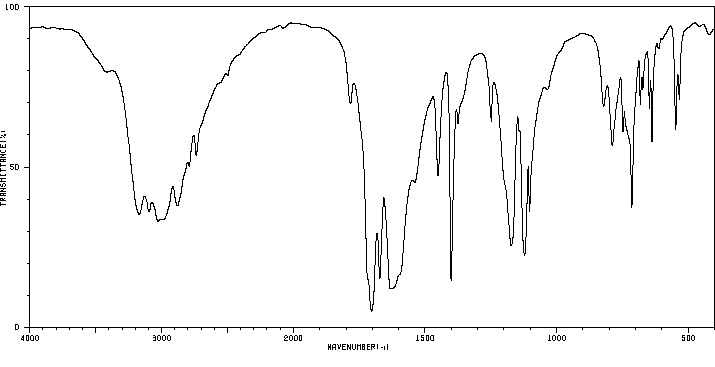5,5-二氯巴比妥酸 | 699-40-1
中文名称
5,5-二氯巴比妥酸
中文别名
——
英文名称
5,5-Dichlor-barbitursaeure
英文别名
5,5-dichlorobarbituric acid;5,5-dichloro-1,3-diazinane-2,4,6-trione
CAS
699-40-1
化学式
C4H2Cl2N2O3
mdl
MFCD04037267
分子量
196.977
InChiKey
REGZNRJTBVIGMJ-UHFFFAOYSA-N
BEILSTEIN
——
EINECS
——
-
物化性质
-
计算性质
-
ADMET
-
安全信息
-
SDS
-
制备方法与用途
-
上下游信息
-
文献信息
-
表征谱图
-
同类化合物
-
相关功能分类
-
相关结构分类
计算性质
-
辛醇/水分配系数(LogP):-0.2
-
重原子数:11
-
可旋转键数:0
-
环数:1.0
-
sp3杂化的碳原子比例:0.25
-
拓扑面积:75.3
-
氢给体数:2
-
氢受体数:3
安全信息
-
海关编码:2933540000
SDS
上下游信息
反应信息
-
作为反应物:描述:参考文献:名称:Biltz; Hamburger, Chemische Berichte, 1916, vol. 49, p. 639摘要:DOI:
-
作为产物:描述:参考文献:名称:Biltz; Hamburger, Chemische Berichte, 1916, vol. 49, p. 639摘要:DOI:
文献信息
-
Conversion of Nucleophilic Halides to Electrophilic Halides: Efficient and Selective Halogenation of Azinones, Amides, and Carbonyl Compounds Using Metal Halide/Lead Tetraacetate作者:Su-Dong Cho、Yong-Jin Yoon、Jeum-Jong Kim、Deok-Heon Kweon、Ho-Kyun Kim、Sang-Gyeong LeeDOI:10.1055/s-2006-926224日期:——AlCl 3 /Pb(OAc) 4 and ZnBr 2 /Pb(OAc) 4 are efficient electrophilic N- and α-C-halogenating agents. A variety of azinones, amides and carbonyl compounds were chemoselectively and regioselectively N-, or α-C-halogenated in good to excellent yield using AlCl 3 /Pb(OAc) 4 and ZnBr 2 /Pb(OAc) 4 in acetonitrile.
-
Ylide von Barbitursäuren mit Nicotinsäurederivaten als kationischem Strukturelement作者:Eduard Peichl、Thomas KappeDOI:10.1002/ardp.19843171109日期:——Pyridinium‐Ylide von Barbitursäuren 3a‐f lassen sich durch Umsetzung der 5‐Chlor‐, 5,5‐Dichlor‐oder 5,5‐Dibrom‐barbitursäuren 1a‐d mit Pyridin (2a) und den Nicotinsäurederivaten 2b‐d gewinnen. Katalytische Hydrierung an Pd oder Pt liefert aus 3b,f die substituierten 5‐Piperidyl‐barbitursäuren 4a,b. Mit Na‐ethylat in Ethanol erhält man aus 3f ein oligomeres Produkt, für welches Struktur 5 vorgeschlagen
-
A new enzymatic chlorination of barbituric acid and its 1-methyl and 1,3-dimethyl derivatives作者:M. C. R. Franssen、H. C. van der PlasDOI:10.1002/recl.19841030306日期:——A new chlorination procedure, involving as reagent the system chloroperoxidase/hydrogen peroxide/potassium chloride was developed for converting barbituric acid, 1-methylbarbituric acid and 1,3-dimethylbarbituric acid into their 5,5-dichloro derivatives. It could be proved that the corresponding 5-mono-chlorobarbituric acids are intermediates in the reaction.
-
Barbiturates with hydrogen-bonded layer and framework structures作者:Thomas Gelbrich、Denise Rossi、Clemens A. Häfele、Ulrich J. GriesserDOI:10.1039/c1ce05430a日期:——Four N–H⋯OC bonded structures for 5,5-substituted derivatives of barbituric acid are reported, which are distinct from the eight fundamental types that have been previously described. The N–H⋯OC-bonded layer structures L-4, L-5 and L-6 are present in crystal polymorphs of 5-(2-bromoallyl)-5-isopropyl barbituric acid (L-4: 1, noctal), 5,5-dichlorobarbituric acid (L-6: 2a, L-5: 2b) and 5,5-dibromobarbituric acid (L-5: 3a). The monoclinic polymorph (3b) of the dibromo compound contains the framework F-2. In each case, the essential building block consists of two molecules which are doubly N–H⋯OC-bonded via a central R22(8) ring. The L-4 structure is closely related to the common 1D ladder topology C-4. It serves also as a building unit for the L-5 sandwich structure. The essential rings of L-4 and L-6 have the same graph-set descriptor R66(28) but are topologically distinct from one another. In the F-2 framework, ten molecules are linked together to give an L-shaped R1010(48) ring. The IR spectra of the crystal forms 1, 2a–b and 3a–b are discussed and a previously established classification scheme correlating the H-bonding of barbiturates with their IR characteristics is extended.本文报道了四种N-H⋯OC键合结构的5,5-取代巴比妥酸衍生物,它们与之前描述的八种基本类型不同。N-H⋯OC键合层结构L-4、L-5和L-6存在于5-(2-溴烯丙基)-5-异丙基巴比妥酸(L-4:1,noctal)、5,5-二氯巴比妥酸(L-6:2a,L-5:2b)和5,5-二溴巴比妥酸(L-5:3a)的晶体多晶型中。二溴化合物的单斜多晶型(3b)包含F-2框架。在每种情况下,基本结构单元由两个分子组成,它们通过中心R22(8)环形成双N-H⋯OC键。L-4结构与常见的1D阶梯拓扑结构C-4密切相关。它也是L-5三明治结构的构建单元。L-4和L-6的基本环具有相同的图形集描述符R66(28),但在拓扑上彼此不同。在F-2框架中,十个分子连接在一起形成L形的R1010(48)环。本文讨论了晶体1、2a-b和3a-b的红外光谱,
-
Verfahren zur Herstellung von 2,4,5,6-Tetrachlorpyrimidin申请人:BAYER AG公开号:EP0101561A1公开(公告)日:1984-02-29Es wird ein neues Verfahren zur Herstellung von 2,4,5,6-Tetrachlorpyrimidin (TCP) bereitgestellt. Das Verfahren ist dadurch gekennzeichnet, dass man in eine 5,5-Dichlorbarbitursäure und Phosphoroxychlorid enthaltende Mischung, Phosphartrichlorid und Chlor in Gegenwart geringer Mengen eines tertiären Amins bei 90 bis 107°C simultan eindosiert und das entstehende Tetrachlorpyrimidin nach erfolgter Umsetzung abtrennt.
表征谱图
-
氢谱1HNMR
-
质谱MS
-
碳谱13CNMR
-
红外IR
-
拉曼Raman
-
峰位数据
-
峰位匹配
-
表征信息
同类化合物
(S)-3-(2-(二氟甲基)吡啶-4-基)-7-氟-3-(3-(嘧啶-5-基)苯基)-3H-异吲哚-1-胺
(6-羟基嘧啶-4-基)乙酸
(4,5-二甲氧基-1,2,3,6-四氢哒嗪)
鲁匹替丁
马西替坦杂质7
马西替坦杂质4
马西替坦杂质
马西替坦原料药杂质D
马西替坦原料药杂质B
马西替坦
顺式-4-{[5-溴-2-(2,5-二甲基-1H-吡咯-1-基)-6-甲基嘧啶-4-基]氨基}环己醇
非沙比妥
非巴氨酯
非尼啶醇
青鲜素钾盐
雷特格韦钾盐
雷特格韦相关化合物E(USP)
雷特格韦杂质8
雷特格韦EP杂质H
雷特格韦-RT9
雷特格韦
阿西莫司杂质3
阿西莫司
阿脲四水合物
阿脲一水合物
阿维霉素
阿米美啶
阿米洛利
阿米妥钠
阿洛巴比妥
阿普瑞西他滨
阿普比妥
阿巴卡韦相关化合物B(USP)
阿卡明
阿伐那非杂质V
阿伐那非杂质1
阿伐那非杂质
阿伐那非中间体
阿伐那非
铂(2+)二氯化6-甲基-1,3-二{2-[(2-甲基丙基)硫烷基]乙基}嘧啶-2,4(1H,3H)-二酮(1:1)
钴1,2,3,6-四氢-2,6-二氧代嘧啶-4-羧酸酯(1:2)
钠5-烯丙基-4,6-二氧代-1,4,5,6-四氢-2-嘧啶醇酸酯
钠5-乙基-4,6-二氧代-1,4,5,6-四氢-2-嘧啶醇酸酯
钠5-(2-溴丙-2-烯基)-5-丁烷-2-基-4,6-二氧代-1H-嘧啶-2-醇
醌肟腙
酒石酸噻吩嘧啶
那可比妥
辛基2,6-二氧代-1,2,3,6-四氢-4-嘧啶羧酸酯
赛乐西帕杂质3
赛乐西帕KSM3







